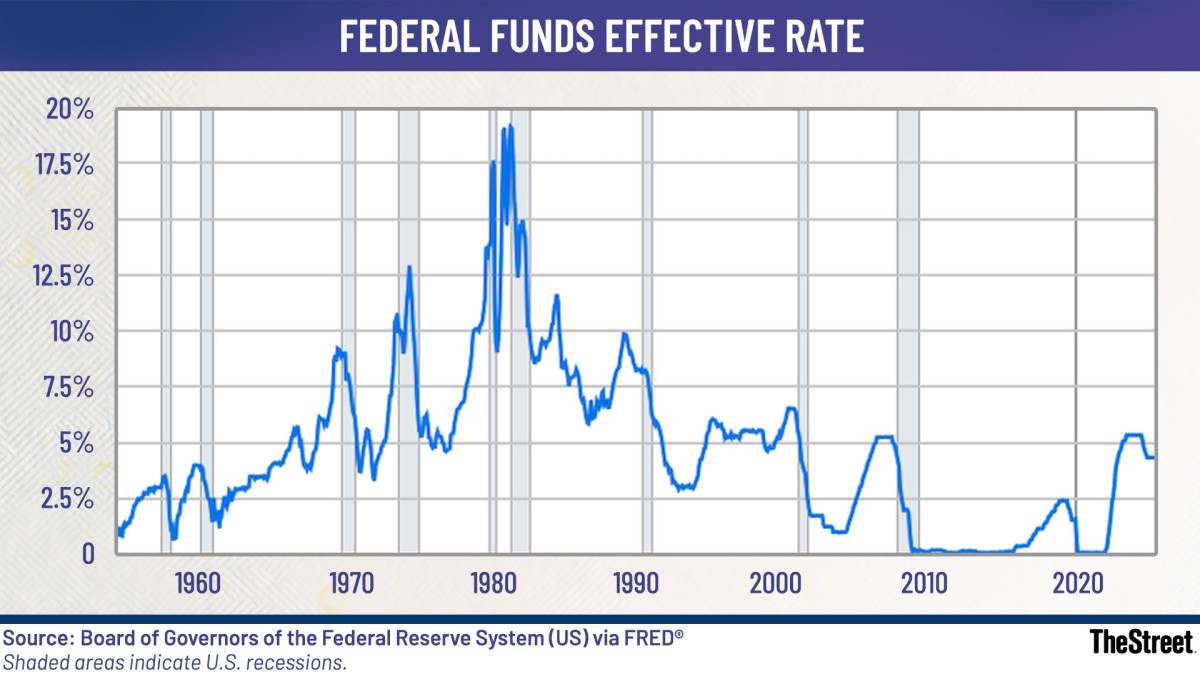Keep your fingers crossed, mortgage hunters.
- Even though the Federal Reserve doesn’t control the nation’s mortgage rates, it does set them in action.
- So does the U.S. labor market, which is really hurting big time, if the latest jobs data from federal and state agencies are to be believed.
The independent central bank will decide soon whether to cut interest rates to shore up the weakening jobs market and support economic growth or continue to hold rates steady to ward off higher-than-targeted inflation.
The Fed meets Sept. 17 and is expected to cut the benchmark Federal Funds Rate currently at 4.25% to 4.50% by a quarter point.
Some Fed watchers are even saying the Federal Open Markets Committee will vote on a half-point cut.
Here’s why these different moving parts of the economy are bringing joy to mortgage hunters.

Source: Board of Governors of the Federal Reserve System
Inflation, jobs are tied to interest rates
- The Federal Reserve has a dual mandate from Congress to execute monetary policy that ensures maximum employment and price stability.
- The Fed has held the benchmark Federal Funds Rate steady since December 2024 at 4.25% to 4.50% in a “wait-and-see” approach for the impact of tariffs on inflation in the supply chain.
- Fed Chair Jerome Powell recently signaled an interest rate cut could be warranted in the near future amid a “shifting balance of risks.”
Weak jobs report spike hopes for interest-rate cut
- The nation’s economy added 911,000 fewer jobs in the 12 months ending in March.
- The report marks the largest preliminary revision on record going back to 2000.
- The revision represents the largest by the BLS since 2009 during the financial crisis.
- Meanwhile, August job growth slowed to a crawl, and the unemployment rate rose to its highest level since the Covid fall of 2021.
Sticky inflation keeps going up
The overall Consumer Price Index in August ticked up to 0.04%, after rising 0.2% in July, the BLS reported Sept. 11.
- Food, energy, and shelter prices pushed up the August CPI monthly figures.
- Over the last 12 months, the all-items index increased 2.9% as expected. The index for all items less food and energy rose 0.3%, as it did in July.
- The Personal Consumption Expenditures index, the Fed’s preferred inflation gauge that tracks what people actually spend, including health care costs, increased 2.6%.
Treasury yields drive mortgage rates
In general, weaker jobs numbers prompt investors to buy bonds.
- Mortgage rates closely follow the yield on the 10-year Treasury note, which investors see as the safest long-term asset.
- Strong investor demand for Treasurys lowers the yields, which usually pushes mortgage rates down to make home loans cheaper.
- Rising inflation pressures Treasury yields higher, which translates into more expensive mortgages for homebuyers or owners looking to refinance.
Mortgage rates drop as jobs numbers plummet
Bankrate reported the average rate for a 30-year fixed mortgage was 6.46% on Sept. 1, an increase of 0.10 basis points over the last week.
This time a month ago, the average rate on a 30-year fixed mortgage was higher, at 6.66%.
At the current average rate, you’ll pay $75.53 for every $100,000 you borrow.
Related: Mounting concerns rattle Federal Reserve watchers
“The 30-year fixed-rate mortgage fell 15 basis points from last week, the largest weekly drop in the past year,” Freddie Mac Chief Economist Sam Khater told Mortgage Reports.
“Mortgage rates are headed in the right direction and homebuyers have noticed, as purchase applications reached the highest year-over-year growth rate in more than four years,” Khater added.
What’s ahead at the Fed
The CME Group FedWatch Tool shows a 93.4% chance of a quarter-point rate cut and a 6.6% chance of a half-point cut in September.
“I think the economy is weakening,” JPMorgan CEO Jamie Dimon said. “Whether it’s on the way to recession or just weakening, I don’t know.”
Some economists said a more dovish Fed could add 0.25% rate cuts in October and December, then another three in 2026.
Related: JPMorgan’s Dimon issues stark recession message after jobs shock
#Looming #Fed #interestrate #cut #cheaper #mortgages